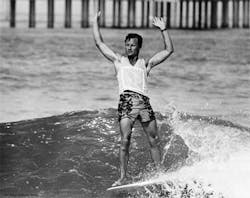Surf's Up! Researchers Explore Wave Energy Converter
As a teenager growing up in Huntington Beach, CA – the original “Surf City” (yes, the town even trademarked the Surf City USA name!) – the sound of someone shouting “surf’s up” was our rallying cry! One of our greatest thrills was seeing Corky Carroll win the U.S. Surfing Championship at the Huntington Beach pier in 1969. Some of you may have seen it "live" back then on ABC’s Wide World of Sports, but we were there!
When tested in the University of Edinburgh’s FloWave Ocean Energy Research Facility’s wave tank – "a circular 2 m-deep basin with a diameter of 25 m, circumferentially ringed by 168 absorbing wave makers" – the device produced peak power of up to 3.8W. According to the researchers, at commercial scale that would equate to several hundred kW (500kW could economically power 100 homes in coastal areas).
Granted, the waves off the coast of the barrier island in South Florida, where I now live, are not nearly as impressive as those in Huntington Beach. So it’s not often that we hear the cry of “surf’s up” here. But I would be certainly excited to hear “power’s on” when the waves break, regardless of their shape!
BONUS: For more on Corky Carroll, here's a vintage video from 1973:
A regular contributor to HPAC Engineering and a member of its editorial advisory board, the author is a principal at Sustainable Performance Solutions LLC, a south Florida-based engineering firm focusing on energy and sustainability.


